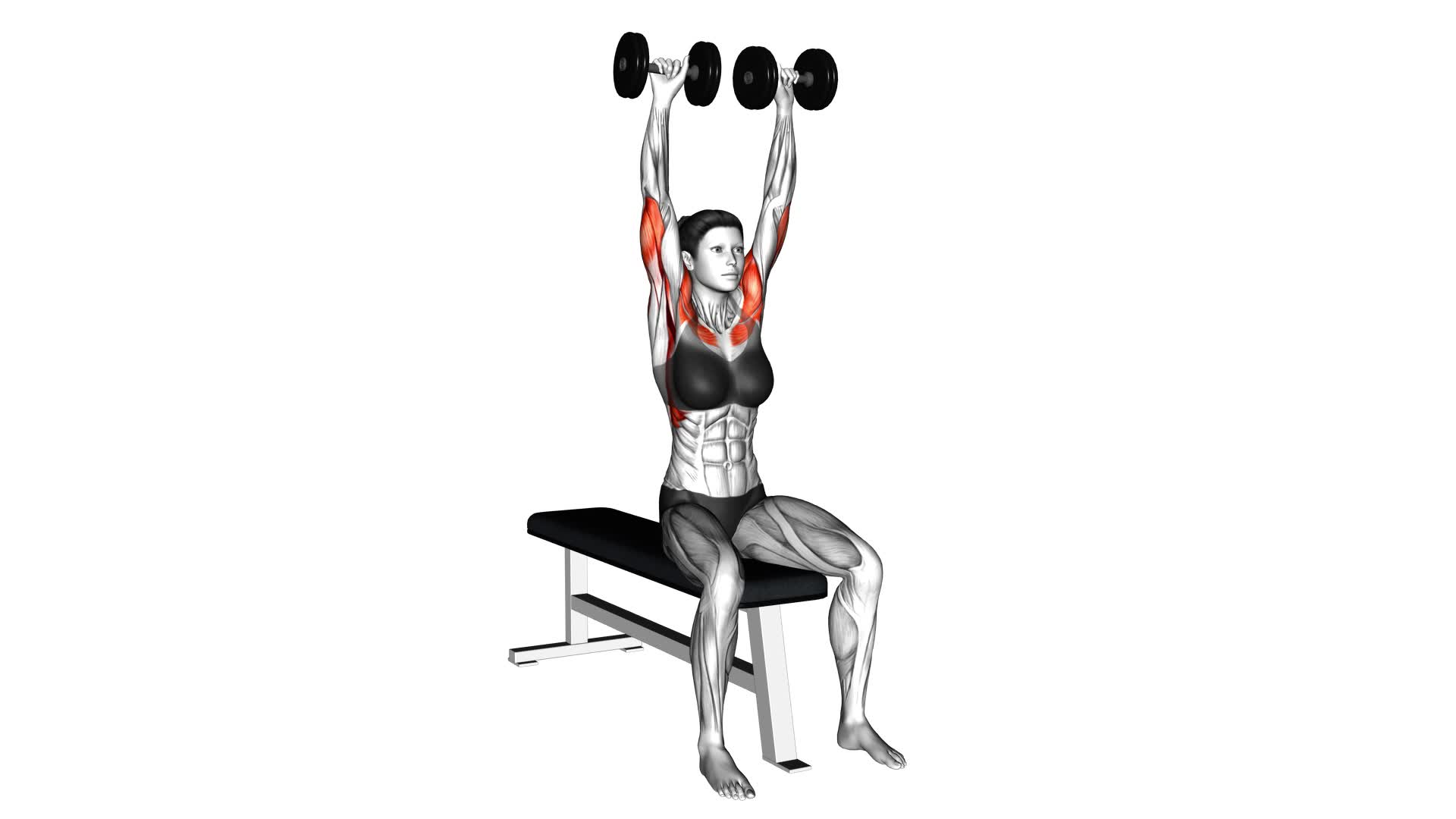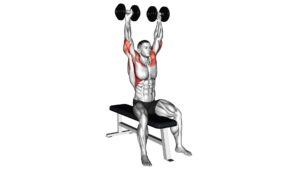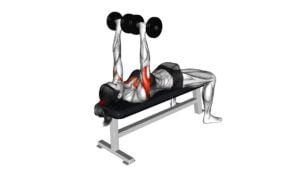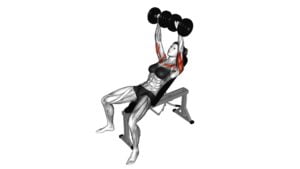Dumbbell Bench Seated Press (female) – Video Exercise Guide & Tips

Are you looking to strengthen your upper body and improve your pressing power?
Watch This Exercise Video
Then the Dumbbell Bench Seated Press is the perfect exercise for you.
In this video exercise guide, we'll show you the correct dumbbell selection, proper seated positioning, and the right form and technique to maximize your results.
Whether you're a beginner or advanced, this exercise offers variations and progressions to challenge and push your limits.
Get ready to level up your fitness game and prevent injuries with our helpful tips.
Let's get started!
Key Takeaways
- Choose dumbbells appropriate for strength and fitness level
- Sit with back straight and shoulders relaxed
- Keep elbows at a 90-degree angle throughout the exercise
- Prioritize proper form and technique to avoid injuries
Correct Dumbbell Selection
To ensure optimal results, choose dumbbells that are appropriate for your strength and fitness level. The dumbbell weight you select is crucial for effective and safe workouts. Using weights that are too heavy can lead to injury, while using weights that are too light may not provide enough resistance to challenge your muscles. When it comes to dumbbell weight selection, it's important to find a balance that allows you to perform the exercises with proper form and technique, while still challenging your muscles.
When choosing dumbbells, consider your current strength and fitness level. If you're a beginner or have limited strength, start with lighter weights to master the movements and build a solid foundation. As you progress and become more comfortable with the exercises, gradually increase the weight to continue challenging your muscles.
In addition to considering your strength, it's also important to choose dumbbells that are comfortable to hold and easy to grip. The shape and texture of the dumbbell handles can vary, so try different options to find what works best for you.
Proper Seated Positioning
Sit with your back straight and shoulders relaxed to maintain proper seated positioning during the dumbbell bench seated press exercise. Maintaining proper seated positioning is crucial for maximizing the benefits and advantages of this exercise while avoiding common mistakes.
One of the main benefits of maintaining proper seated positioning is that it helps to engage the targeted muscles more effectively. By sitting with your back straight, you can ensure that your core muscles are activated, providing stability and support during the exercise. This allows you to generate more power and control throughout the movement, leading to better overall results.
Additionally, sitting with your shoulders relaxed helps to prevent unnecessary strain and tension in the upper body. This allows you to focus on the muscles you're targeting, rather than wasting energy on unnecessary tension. It also helps to reduce the risk of injury and discomfort.
Common mistakes to avoid when it comes to seated positioning include slouching or hunching the back, and tensing the shoulders. Slouching can impede proper form and limit the effectiveness of the exercise. Tensing the shoulders can lead to unnecessary strain and decrease your ability to perform the exercise correctly.
Form and Technique
Maintain proper form and technique by keeping your elbows at a 90-degree angle throughout the dumbbell bench seated press exercise. This is crucial to ensure that you're effectively targeting the appropriate muscle groups and avoiding common mistakes. By keeping your elbows at a 90-degree angle, you engage your shoulders, triceps, and chest muscles more effectively, maximizing the benefits of the exercise.
One common mistake to avoid is allowing your elbows to flare out to the sides during the movement. This not only puts unnecessary strain on your shoulders but also takes away the emphasis from the targeted muscles. To prevent this, focus on keeping your elbows in line with your shoulders throughout the exercise.
Another common mistake is using too much weight, which can compromise your form and lead to injuries. It's important to start with a weight that allows you to maintain proper form and gradually increase the weight as you progress.
Incorporating the dumbbell bench seated press into your workout routine provides several benefits. It helps to build strength and muscle in your shoulders, triceps, and chest. Additionally, it improves shoulder stability and enhances upper body pressing strength, which can be beneficial for various sports and daily activities.
Variations and Progressions
Continue challenging yourself and advancing your workout by exploring different variations and progressions of the dumbbell bench seated press exercise.
Here are some options to consider:
- Different Hand Positions: By changing your hand positions, you can target different muscles and add variety to your workout. Try using a neutral grip, where your palms face each other, or a pronated grip, where your palms face forward. Experiment with different hand positions to find what works best for you.
- Adding a Stability Ball: Incorporating a stability ball into your dumbbell bench seated press can increase the challenge by engaging your core muscles for stability. Instead of sitting on a bench, sit on a stability ball and perform the exercise as usual. This will require more balance and coordination, making your workout more intense.
- Progressing in Weight: As you become stronger, it's important to gradually increase the weight you're lifting. This will help you continue to challenge your muscles and make progress. Start by adding small increments of weight and gradually work your way up to heavier dumbbells.
Safety and Injury Prevention
To prevent injuries during the dumbbell bench seated press exercise, prioritize proper form and technique. This will ensure that you engage the correct muscles and avoid putting unnecessary strain on your joints. One of the most common mistakes is using too much weight, which can lead to improper form and increase the risk of injury. Start with a weight that allows you to perform the exercise with control and gradually increase it as your strength improves.
Another important aspect of injury prevention is warming up properly before starting the exercise. This helps to increase blood flow to the muscles, improve flexibility, and reduce the risk of muscle strains or tears. Incorporate warm-up exercises that target the muscles involved in the dumbbell bench seated press, such as shoulder circles, arm swings, and light dumbbell presses.
Additionally, make sure to maintain a stable and neutral spine throughout the exercise. Avoid arching your back or rounding your shoulders, as this can put excessive stress on your spine and increase the risk of injury. Focus on keeping your core engaged and your shoulder blades pulled back and down.
Frequently Asked Questions
How Many Sets and Reps Should I Do for the Dumbbell Bench Seated Press?
To determine the number of sets and reps for the dumbbell bench seated press, it's important to consider your fitness level and goals.
Start with a weight that challenges you but allows you to maintain proper form. Aim for 3-4 sets of 8-12 reps.
As you progress, gradually increase the weight while maintaining the same number of sets and reps.
Remember to listen to your body and make modifications as needed to prevent injury and optimize your workout.
Can I Perform the Dumbbell Bench Seated Press Without a Bench?
Yes, you can perform the dumbbell bench seated press without a bench.
There are alternative exercises and modifications you can try. For example, you can perform the dumbbell seated press on a stability ball or even on the floor.
This will help engage your core muscles while still targeting your shoulders and chest.
Make sure to maintain proper form and start with lighter weights if you're new to this exercise.
What Are the Benefits of Incorporating the Dumbbell Bench Seated Press Into My Workout Routine?
Incorporating the dumbbell bench seated press into your workout routine can offer numerous benefits. It helps to strengthen your chest, shoulders, and triceps, while also improving your stability and balance.
Additionally, this exercise allows you to work each side of your body independently, helping to correct any muscular imbalances.
There are also variations of the dumbbell bench seated press that can target different muscles and add variety to your workout.
Should I Use a Spotter While Performing the Dumbbell Bench Seated Press?
When performing the dumbbell bench seated press, it's highly recommended to have a spotter. This exercise involves heavy weights and can put strain on your muscles. A spotter can provide assistance if you struggle to lift the weights or if you need help with proper form and technique.
They can also ensure your safety and prevent any potential injuries. So, it's always a good idea to have a spotter by your side while doing the dumbbell bench seated press.
Can I Use a Resistance Band Instead of Dumbbells for the Seated Press Exercise?
Yes, you can use a resistance band as an alternative to dumbbells for the seated press exercise. Resistance band modifications are a great way to add variety and challenge to your workouts.
By using a resistance band, you can still target your chest, shoulders, and triceps muscles just like with dumbbells.
Make sure to choose a resistance band that provides enough tension for your desired level of difficulty.
Conclusion
In conclusion, the dumbbell bench seated press is an effective exercise for females looking to strengthen their upper body. By selecting the correct dumbbell weight, maintaining proper seated positioning, and using the correct form and technique, you can maximize the benefits of this exercise.
Remember to progress gradually and prioritize safety to prevent any potential injuries. Incorporate variations to keep challenging your muscles and continue making progress in your fitness journey.

Author
Years ago, the spark of my life’s passion ignited in my mind the moment I stepped into the local gym for the first time. The inaugural bead of perspiration, the initial endeavor, the very first surge of endorphins, and a sense of pride that washed over me post-workout marked the beginning of my deep-seated interest in strength sports, fitness, and sports nutrition. This very curiosity blossomed rapidly into a profound fascination, propelling me to earn a Master’s degree in Physical Education from the Academy of Physical Education in Krakow, followed by a Sports Manager diploma from the Jagiellonian University. My journey of growth led me to gain more specialized qualifications, such as being a certified personal trainer with a focus on sports dietetics, a lifeguard, and an instructor for wellness and corrective gymnastics. Theoretical knowledge paired seamlessly with practical experience, reinforcing my belief that the transformation of individuals under my guidance was also a reflection of my personal growth. This belief holds true even today. Each day, I strive to push the boundaries and explore new realms. These realms gently elevate me to greater heights. The unique combination of passion for my field and the continuous quest for growth fuels my drive to break new ground.







